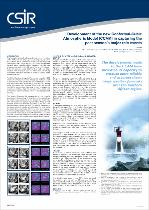 ResearchSpace
ResearchSpace
Development of the new Conformal-Cubic Atmospheric Model (CCAM) in capturing the past season’s major rain events
JavaScript is disabled for your browser. Some features of this site may not work without it.
- ResearchSpace
- →
- Research Publications/Outputs
- →
- Conference Publications
- →
- View Item
| dc.contributor.author |
Park, R

|
|
| dc.date.accessioned | 2010-09-02T11:11:49Z | |
| dc.date.available | 2010-09-02T11:11:49Z | |
| dc.date.issued | 2010-09-01 | |
| dc.identifier.citation | Park, R. 2010. Development of the new Conformal-Cubic Atmospheric Model (CCAM) in capturing the past season’s major rain events. CSIR 3rd Biennial Conference 2010. Science Real and Relevant. CSIR International Convention Centre, Pretoria, South Africa, 30 August – 01 September 2010, pp 1 | en |
| dc.identifier.uri | http://hdl.handle.net/10204/4309 | |
| dc.description | CSIR 3rd Biennial Conference 2010. Science Real and Relevant. CSIR International Convention Centre, Pretoria, South Africa, 30 August – 01 September 2010 | en |
| dc.description.abstract | The Atmospheric Modelling Strategic Initiative is a new initiative at the CSIR, and has only begun producing daily forecasts for southern Africa (and the Southern Africa Development Community – SADC) as of January 2010. These forecasts are currently being made for rainfall, maximum and minimum temperatures, and wind fields using the new Conformal- Cubic Atmospheric Model (CCAM). This model has been adapted and developed since its initialisation, increasing its weather prediction capability in order to produce more reliable forecasts. The CCAM has been integrated from coarse resolution (200 km) to a much higher resolution (15 km), and this has resulted in considerably more specific and accurate forecasts. In the past March-April-May season there have occurred several major rain events over southern Africa, which the model was able to capture; and depending on how developed the model was (and how high the resolution of the model was at that time), it predicted these events at varying degrees of accuracy. This poster illustrates the progression of the model’s development by analysing its prediction performance from the initial coarse resolution to the current fine resolution. This will be done by comparing the output 4-day rainfall forecasts of the two different resolutions to the real-time satellite images of those four days. The satellite images show the cloud bands of specific rainfall events that took place during March, April and May 2010 – the most recent season. It will be highlighted that the output forecasts have become progressively more specific and defined in area, and more accurate in predicting rainfall and intensity of rainfall, and this improvement is a result of the recent model developments | en |
| dc.language.iso | en | en |
| dc.publisher | CSIR | en |
| dc.subject | Conformal cubic atmospheric model | en |
| dc.subject | CCAM | en |
| dc.subject | Rain events | en |
| dc.subject | Atmospheric modelling | en |
| dc.subject | Atmospheric modelling strategic initiative | en |
| dc.subject | CSIR Conference 2010 | en |
| dc.title | Development of the new Conformal-Cubic Atmospheric Model (CCAM) in capturing the past season’s major rain events | en |
| dc.type | Conference Presentation | en |
| dc.identifier.apacitation | Park, R. (2010). Development of the new Conformal-Cubic Atmospheric Model (CCAM) in capturing the past season’s major rain events. CSIR. http://hdl.handle.net/10204/4309 | en_ZA |
| dc.identifier.chicagocitation | Park, R. "Development of the new Conformal-Cubic Atmospheric Model (CCAM) in capturing the past season’s major rain events." (2010): http://hdl.handle.net/10204/4309 | en_ZA |
| dc.identifier.vancouvercitation | Park R, Development of the new Conformal-Cubic Atmospheric Model (CCAM) in capturing the past season’s major rain events; CSIR; 2010. http://hdl.handle.net/10204/4309 . | en_ZA |
| dc.identifier.ris | TY - Conference Presentation AU - Park, R AB - The Atmospheric Modelling Strategic Initiative is a new initiative at the CSIR, and has only begun producing daily forecasts for southern Africa (and the Southern Africa Development Community – SADC) as of January 2010. These forecasts are currently being made for rainfall, maximum and minimum temperatures, and wind fields using the new Conformal- Cubic Atmospheric Model (CCAM). This model has been adapted and developed since its initialisation, increasing its weather prediction capability in order to produce more reliable forecasts. The CCAM has been integrated from coarse resolution (200 km) to a much higher resolution (15 km), and this has resulted in considerably more specific and accurate forecasts. In the past March-April-May season there have occurred several major rain events over southern Africa, which the model was able to capture; and depending on how developed the model was (and how high the resolution of the model was at that time), it predicted these events at varying degrees of accuracy. This poster illustrates the progression of the model’s development by analysing its prediction performance from the initial coarse resolution to the current fine resolution. This will be done by comparing the output 4-day rainfall forecasts of the two different resolutions to the real-time satellite images of those four days. The satellite images show the cloud bands of specific rainfall events that took place during March, April and May 2010 – the most recent season. It will be highlighted that the output forecasts have become progressively more specific and defined in area, and more accurate in predicting rainfall and intensity of rainfall, and this improvement is a result of the recent model developments DA - 2010-09-01 DB - ResearchSpace DP - CSIR KW - Conformal cubic atmospheric model KW - CCAM KW - Rain events KW - Atmospheric modelling KW - Atmospheric modelling strategic initiative KW - CSIR Conference 2010 LK - https://researchspace.csir.co.za PY - 2010 T1 - Development of the new Conformal-Cubic Atmospheric Model (CCAM) in capturing the past season’s major rain events TI - Development of the new Conformal-Cubic Atmospheric Model (CCAM) in capturing the past season’s major rain events UR - http://hdl.handle.net/10204/4309 ER - | en_ZA |





